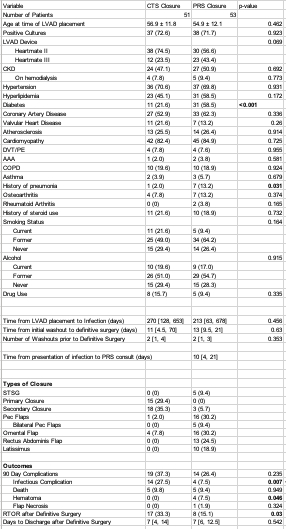Plastic Surgery Involvement with Surgical Management of Infected Ventricular Assist Devices Decreased Lifetime RTOR and 90 Day Complications.
Keith R. Sweitzer*, Cody Fowler, James Butterfield, Adam Visca, Danielle Mayorga-Young, Julia Tomtschik, Raquel Arias-Camison, Derek Bell
Plastic Surgery, University of Rochester, Rochester, NY
The use of ventricular assist devices (VADs) for patients with end-stage cardiac failure awaiting heart transplantation has become increasingly common. However, VAD related infections remain a major problem complicating their long-term use. We wished to determine if early plastic surgery intervention led to a decreased length of stay, RTOR, or complications for these patients.
LVAD patients readmitted for LVAD infection at a single institution from 2008-2021 were identified using a pre-existing database. Patients were followed retrospectively for an average of 3.2 years. Patient demographics, preoperative diagnosis/disease state, type of ventricular assist device inserted, postoperative day of ventricular assist device infection onset, definitive device coverage, timing of coverage procedure after the initial washout for infection, type of flap used for coverage, 90 day complications following definitive coverage and lifetime return to OR for infection was reviewed. Comparison analysis with Chi squared and ANOVA testing was used to analyze outcomes.
Of 568 patients admitted with an LVAD infection, 104 underwent operative debridement and closure by PRS or CTS. 53 underwent PRS closure, 51 underwent CTS closure. There was an increased incidence of diabetes among the PRS group (p <.001) otherwise there was no difference in baseline characteristics. There was increased RTOR over a lifetime with CTS closure compared to PRS (p=0.03), and increased 90 day risk of infection (p=0.007). PRS clsure patients had an increased risk of post-operative hematoma (p=046). PRS was typically consulted on hospital day 10. Both PRS and CTS closure patients were discharged on POD7 on average (p=0.542)
Plastic Surgery involvement with surgical decision making and closure of infected LVAD devices has a decrease in lifetime RTOR and decreased 90 day complications related to infections. There may be a benefit to earlier PRS consultation for coverage assessment.
Back to 2023 Abstracts


